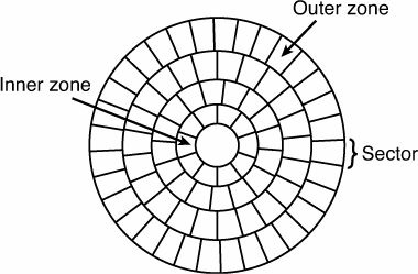Hardware Reference
In-Depth Information
Figure 9.7. Standard recording, where the same number of sectors comprises every track.
A standard recording wastes capacity on the outer tracks because it is longer yet holds the same
amount of data (more loosely spaced) as the inner tracks. One way to increase the capacity of a hard
drive during the low-level format is to create more sectors on the disks' outer cylinders than on the
inner ones. Because they have a larger circumference, the outer cylinders can hold more data. Drives
without zoned recording store the same amount of data on every cylinder, even though the tracks of the
outer cylinders might be twice as long as those of the inner cylinders. The result is wasted storage
capacity because the disk medium must be capable of storing data reliably at the same density as on
the inner cylinders. When the number of sectors per track is fixed, as in older controllers, the drive
capacity is limited by the density of the innermost (shortest) track.
Drives that use zoned recording split the cylinders into groups called
zones
, with each successive
zone having more sectors per track as you move outward from the center of the disk. All the cylinders
in a particular zone have the same number of sectors per track. The number of zones varies with
specific drives, but most drives have between 16 and 32 zones.
Figure 9.8
shows a drive with zoned-bit recording.
Figure 9.8. Zoned recording, where the number of sectors per track increases within each zone,
moving out from the center.
Another effect of zoned recording is that transfer speeds vary depending on which zone the heads are
in. A drive with zoned recording still spins at a constant speed. Because more sectors exist per track
in the outer zones, however, data transfer is fastest there. Consequently, data transfer is slowest when
reading or writing to the inner zones. That is why virtually all drives today report minimum and



